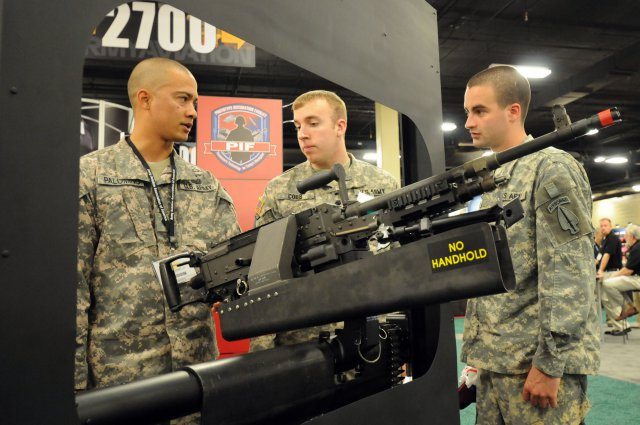The U.S. Army is in the early stages of responding to an Operational Needs Statement asking for high-tech assistance for pilots to better navigate “brown-out” conditions where terrain becomes obscured.
The Army plans to acquire five high-tech, 94 Gigahertz millimeter wave radar systems called Helicopter Autonomous Landing Systems, service officials said April 3 at the 2012 Army Aviation Association of America’s Professional Forum and Exhibition in Nashville.
The systems will help pilots navigate through what’s referred to as a Degraded Visual Environment, or DVE, said Col. Anthony Potts, project manager, Aviation Systems.
The idea for the DVE radar, which emerged out of a specially-formed Helicopter Survivability Task Force started in 2009, is to leverage the best existing technologies able to help pilots navigate through obscured or “brown-out” conditions as a path toward conducting a Limited User Assessment of the technology by the end of next year, Potts explained.
The efforts of the task force resulted in a study titled U.S. Army Program Executive Office Aviation Report and Recommendations on Terrain Awareness Aspects of Rotorcraft Mishaps in Degraded Visual Environments, Aug. 11, 2011.
“We made a determination within that study, the greatest threat to our aircraft was what’s called Degraded Visual Environment. This refers to when a pilot’s approach to the landing zone in desert conditions becomes what is commonly referred to as a “brown out,” where pilots lose their visual reference with the ground,” Potts added.
The danger of a DVE, Potts explained, is when pilots lose their situational awareness regarding what’s referred to as the “drift” of an airframe, wherein an aircraft catches or collides with the ground or nearby obstacle, causing a helicopter to roll over.
The Rotorcraft Mishaps in DVE study, led by PEO Aviation with support from the Army’s Aviation Center of Excellence and the Army Combat Readiness Center, Fort Rucker, Ala., and the Aviation and Missile Command, Redstone Arsenal, Ala., was geared toward looking at ways to help helicopter pilots minimize or avoid what’s often called Controlled Flight Into Terrain, Potts said.
The Army, which has budgeted $226 million for DVE technologies from 2011 to 2015, plans to deliver the first five DVE systems within 18 to 24 months, he added.
At the same time, PEO Aviation, Project Manager Aviation Systems Program Office is expecting that the fielding of the first five systems in response to the ONS will help inform a subsequent program of record for DVE technologies.
“We have an Initial Capabilities Document and we are getting ready to produce a Capabilities Development Document. We’re hoping for an Milestone Development Decision, or MDD by the fourth quarter of this year” Potts said.
PEO Aviation is working with the Special Operations community as well as the Army’s Technology Applications Program Office and the Defense Advanced Research Projects Agency to establish a “backbone” architecture able to accommodate a number of valuable DVE-type technologies, Potts explained.
“There are a lot of sensors out there. We’re working toward a software backbone that can become sensor agnostic so that it is not tied to a specific material solution. We’ve found some great partnerships,” Potts described.
There is some discussion among experts regarding which sensor might be best suited for DVE-type solutions, with potential options including laser applications, ladar, long wave and infrared radar, Potts said.
“What we’ve found is that the millimeter wave radar had the best capability to penetrate the dust obscurants that are in the air. Basically what it does is it paints a picture of the ground in front of you, so that pilots can see the ground from a radar-painted picture,” Potts said. “Also, it will paint an obstacle that might be there, whether it’s a Humvee put in your landing zone, a ditch or a small hole that your map didn’t show was there – and it gives you that visibility.”
The Army’s cutting-edge aircraft models such as the AH-64 Block III Apache attack helicopter, UH-60 M-model Black Hawk utility helicopter and the CH 47 F-model Chinook cargo helicopters all have advanced digital flight controls and moving map displays better able to help pilots navigate, Potts said.










